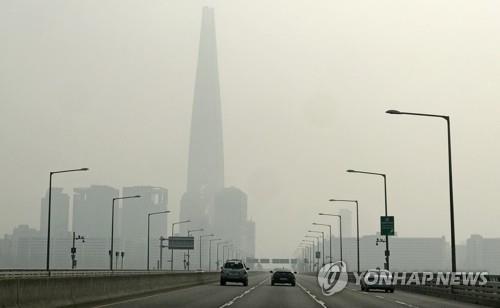Seoul hit by worst level of ultrafine dust

The sky over Seoul, seen from the Jamsil Grand Bridge on the Han River, is thick with fine dust on Jan. 14, 2019. (Yonhap)
SEOUL, Jan 14, 2019, Yonhap. Seoul was hit by a record-high level of ultrafine dust, known as a class one carcinogen, on Monday, as most of South Korea was blanketed by extraordinarily heavy levels of choking dust particles for the fourth consecutive day, reported the Yonhap.
The daily average level of ultrafine particles, smaller than 2.5 micrometers in diameter, in Seoul surged to 118 micrograms per cubic meter as of 3 p.m., the highest figure since the government began taking such measurements in 2015, according to the state-run National Institute of Environmental Research.
The previous daily record of ultrafine dust in the capital was set on March 25 last year, when the figure reached 99 micrograms. The institute said the density of harmful ultrafine dust particles is unlikely to go down over the rest of the day.
The institute explained that the inflow of external fine dust from China and other locations has combined with locally generated pollutants amid stagnant air over the Korean Peninsula. This year’s worst smog was reported in Beijing and its surrounding areas over the weekend.
The fine dust concentration is particularly serious in the nation’s central region, including Seoul and nearby areas. According to Air Korea and other fine dust watchers, Seoul’s fine dust level surged to 194 micrograms per cubic meter as of 4 p.m, with its ultrafine dust fine level reaching 148 micrograms, nearly six times the WHO’s recommended level of 25 micrograms.
South Korea’s authorities have classified the level of ultrafine dust particles above 35 micrograms per cubic meter as “bad” and above 75 micrograms as “very bad.”

Throughout the weekend, the level of ultrafine dust hovered around 80 to 90 micrograms in the capital area, forcing citizens to refrain from outdoor activities.
The latest wave of fine dust began Friday, when cold northern winds gave way to warm winds from China. Seoul Mayor Park Won-soon last week rebutted Beijing’s recent allegation that China has nothing to do with hazardous fine dust over the Korean Peninsula. Park said he has research papers from municipal and state labs that conclude around 50 to 60 percent of fine dust over South Korea is from China.
The Korea Meteorological Administration said the nationwide levels of fine dust will begin to fall Tuesday afternoon, when chilly winds from the north bring down the temperature and blow away the fine dust.
The Seoul Metropolitan Government banned half of public vehicles from the road for the second consecutive day as part of its emergency measures to fight fine dust. It is the third time after January and March last year that the Seoul government has taken emergency anti-dust measures for the second consecutive day.
The Ministry of Environment also took measures to tackle the dust particles and ordered domestic thermal power plants to reduce their output to 80 percent of normal operations.
Most citizens going to work Monday morning were seen wearing masks to protect themselves against harmful ultrafine particles.
“The sky is too thick with fine dust. It’s like seeing a black-and-white TV. I’m afraid of even breathing because of the dark sky,” said a Seoul citizen named Lee.
A Daejeon citizen surnamed Kim said: “Even though I used a mask, my throat is sore and my eyes are irritated. Even the air smells bad from the heavy fine dust.”